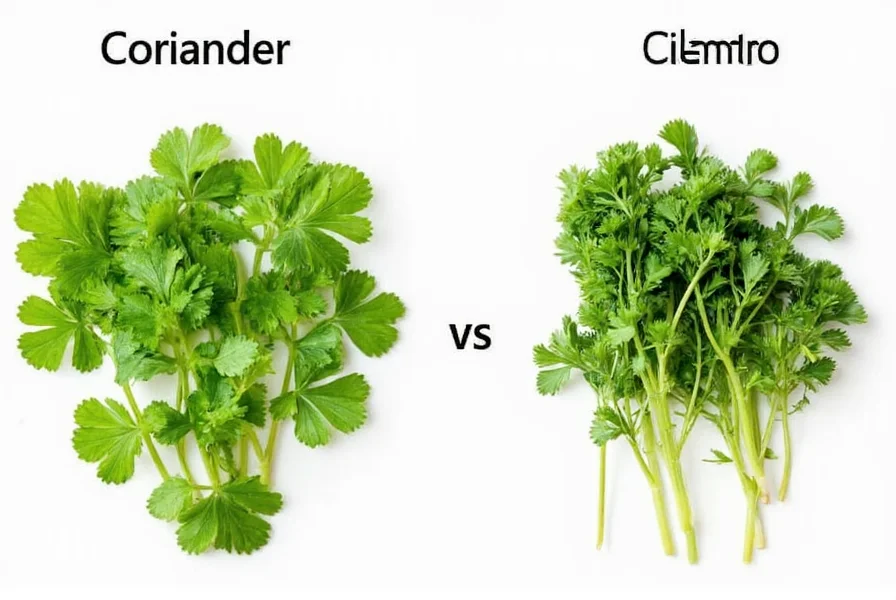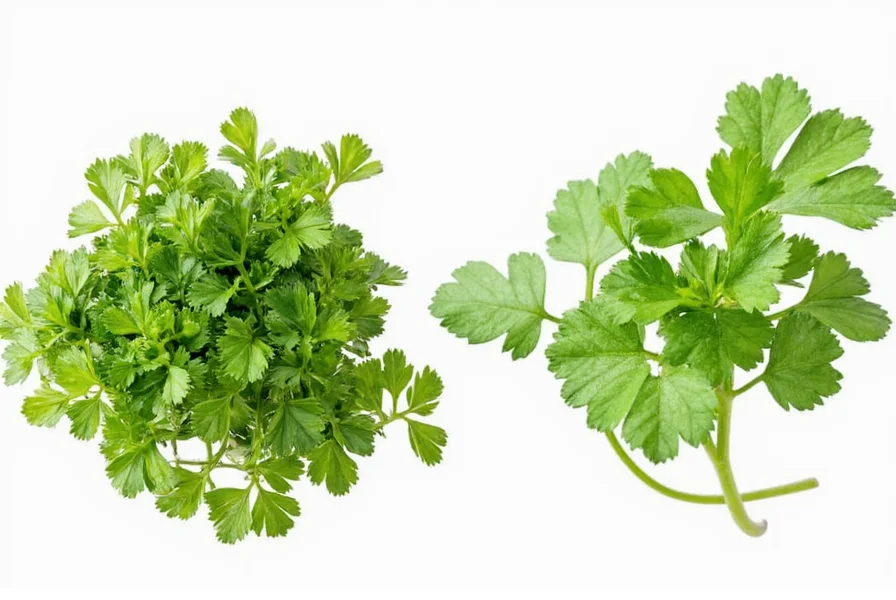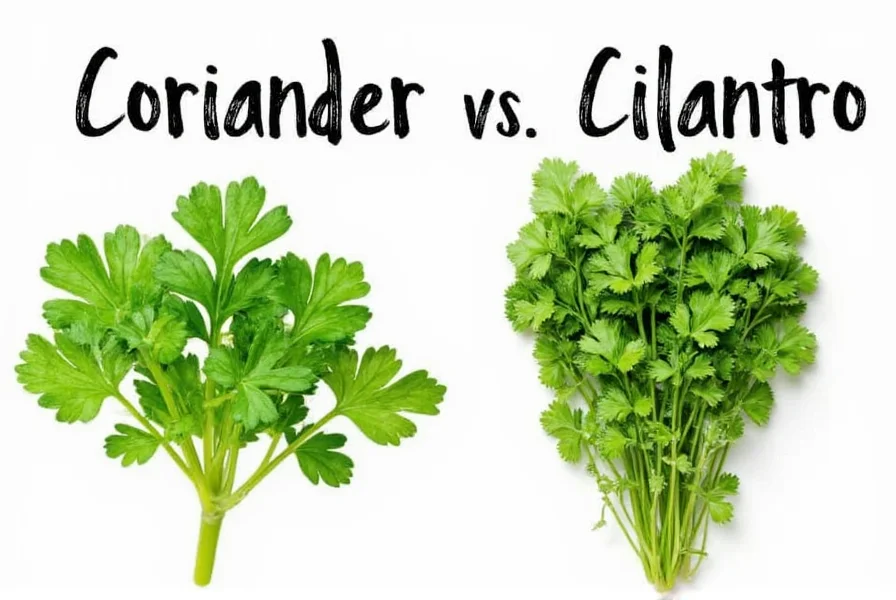Understanding the relationship between coriander and cilantro eliminates confusion in recipes and grocery shopping. This aromatic herb belongs to the Apiaceae family and has been cultivated for over 3,000 years across Mediterranean, Middle Eastern, and Asian cuisines. The terminology difference represents one of the most common points of confusion in global cooking.
The Botanical Reality: One Plant, Two Names
Coriandrum sativum produces both the leafy greens known as cilantro in North America and the spherical seeds called coriander worldwide. The plant grows to about 18-24 inches tall with lacy, bright green leaves and produces small white or pink flowers that develop into the characteristic round seeds.
| Plant Part | North American Term | International Term | Flavor Profile |
|---|---|---|---|
| Leaves & Stems | Cilantro | Coriander (fresh) | Bright, citrusy, sometimes soapy (to genetic tasters) |
| Dried Seeds | Coriander | Coriander seeds | Warm, nutty, lemony, slightly peppery |
| Roots | Rarely used | Coriander root | Intense, earthy, more potent than leaves |
Origin of the Terminology Divide
The word "cilantro" comes from the Spanish adaptation of the Portuguese "cilantropo," which itself derives from the Greek "koris" (bug), referencing the plant's distinctive scent. Spanish-speaking countries and the United States adopted "cilantro" specifically for the leafy portion. Meanwhile, most other English-speaking countries retained "coriander" for both the leaves and seeds, creating the transatlantic confusion.
When exploring international recipes, understanding this terminology difference becomes essential. A British recipe calling for "coriander" likely means the fresh leaves, while an American recipe specifying "coriander" probably refers to the ground seeds. This distinction represents one of the most frequent points of confusion between American and international cooks.
Culinary Applications: Leaves vs. Seeds
The fresh leaves (cilantro/coriander greens) work best as a finishing herb added at the end of cooking. Their delicate flavor diminishes with heat, making them perfect for salsas, chutneys, and garnishes. The seeds, however, benefit from toasting which enhances their warm, citrusy notes—ideal for spice blends, pickling, and baked goods.
Professional chefs recognize that the entire plant offers culinary value:
- Leaves: Essential in Mexican salsas, Thai curry pastes, and Indian chutneys
- Stems: More flavorful than leaves, excellent finely chopped in marinades
- Seeds: Ground for spice rubs or used whole in pickling brines
- Roots: Fundamental in Thai curry pastes for deep flavor foundation
Genetic Factors in Taste Perception
Approximately 21% of the population carries a genetic variation that makes cilantro taste like soap. This OR6A2 gene variant affects olfactory receptors, causing certain aldehydes in cilantro to register as soapy rather than citrusy. This genetic difference explains why some people passionately dislike cilantro while others enjoy its bright flavor.

Substitution Guidance for Cooks
When a recipe calls for fresh cilantro but you only have coriander seeds (or vice versa), proper substitution requires understanding their flavor differences:
- Cilantro substitute: Fresh parsley with a squeeze of lime juice captures some freshness, though not identical
- Coriander seeds substitute: Cumin provides earthiness but lacks citrus notes; fennel seeds offer similar warmth with different flavor profile
For authentic flavor, nothing truly replaces fresh cilantro in dishes where it's essential, such as guacamole or Vietnamese pho. The unique chemical composition of fresh coriander leaves cannot be perfectly replicated by other herbs.
Growing Your Own Coriander/Cilantro
Gardeners can grow this versatile herb with relative ease. Coriandrum sativum prefers cool weather and partial shade in warmer climates. For continuous leaf production, plant seeds every 2-3 weeks throughout the growing season. To harvest seeds, allow plants to flower and develop seed heads, then cut and dry them in paper bags.
Understanding whether your recipe requires the fresh leaves or dried seeds—regardless of what they're called in your region—will dramatically improve your cooking results. This knowledge represents essential culinary literacy for anyone working with global recipes.

Can I use coriander seeds instead of fresh cilantro in salsa?
No, coriander seeds cannot substitute for fresh cilantro in salsa. The seeds have a completely different warm, nutty flavor profile compared to the bright, citrusy freshness of cilantro leaves. For authentic salsa, fresh cilantro is essential to balance the tomatoes and chilies.
Why does cilantro taste like soap to some people?
Approximately 21% of people have a genetic variation (OR6A2 gene) that affects their olfactory receptors, causing certain aldehydes in cilantro to register as soapy rather than citrusy. This genetic difference explains why some individuals perceive cilantro as tasting like soap while others enjoy its fresh flavor.
Is there a difference between coriander leaves and cilantro?
No difference exists between coriander leaves and cilantro—they come from the same plant (Coriandrum sativum). The terminology difference is purely regional: "cilantro" is the term used in the United States for the fresh leaves, while most other English-speaking countries call them "coriander" or "fresh coriander." The seeds are called "coriander" worldwide.
Can I grow cilantro from coriander seeds?
Yes, you can grow cilantro from coriander seeds because they come from the same plant (Coriandrum sativum). The seeds sold as "coriander" in spice aisles will germinate and produce the leafy herb known as cilantro in North America. Simply plant the seeds about 1/4 inch deep in well-draining soil.
Why do recipes sometimes call for coriander when they mean the leaves?
Recipes from outside North America often use "coriander" to refer to both the fresh leaves and dried seeds. This reflects the international standard terminology where "coriander" describes the entire plant. American recipes typically distinguish between "cilantro" (leaves) and "coriander" (seeds), creating confusion when following international recipes.
Final Clarification
The question of whether coriander and cilantro are the same plant has a definitive answer: they originate from Coriandrum sativum. The terminology difference represents regional language variation rather than botanical distinction. Understanding this relationship helps cooks navigate international recipes and grocery store labeling with confidence. Whether you call it cilantro or coriander, recognizing which part of the plant a recipe requires—fresh leaves or dried seeds—makes all the difference in culinary success.











 浙公网安备
33010002000092号
浙公网安备
33010002000092号 浙B2-20120091-4
浙B2-20120091-4